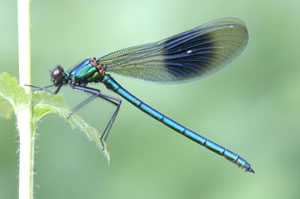Dragonflies and Damselflies
Now the weather is warmer, dragonflies and damselflies are quite common around ponds and areas of water. Their beautiful iridescence and double wings are quite distinctive, but what is the difference between a dragonfly and a damselfly?
Dragonflies are the bigger of the two – with a wingspan of up to 120 mm. Their back pair of wings is shorter and stubbier than the front pair, and, at rest, they hold their wings outstretched. They are strong fliers and can be seen quite far from water. Being daytime hunters, both species use eyesight rather than smell or touch. They both have relatively large eyes, but small, underdeveloped antennae. Dragonflies’ eyes touch.
Damselflies are smaller and stay close to the water. Their two pairs of wings are equal in size and are held against their body at rest. Their eyes are separate.
What do Dragonflies and Damselflies Eat?
They are carnivorous and will eat any small insect, but their diet is mostly midges and mosquitoes. They don’t bite or sting. The larvae are voracious eaters and will eat anything they can catch, usually other aquatic larvae and bloodworms.
What Eats Dragonflies and Damselflies?
Common predators of dragonflies and damselflies are birds, spiders (damselflies are caught in webs) and frogs. The larvae are eaten by frogs, toads, newts, fish and kingfishers.
Why Are They Important?
The British Dragonfly Society has just launched the Dragonflies in Focus Project, a 5-year recording project that will eventually produce the National Dragonfly Atlas. There is evidence that dragon and damselflies are emerging earlier in the spring and new species, such as the Small Red-Eyed Damselfly are becoming established in the UK. Consistent changes in patterns of emergence and distribution may be evidence of global warming. In addition, dragonflies and damselflies are indicators or clean water; they can only breed in oxygen-rich and unpolluted water.
Volunteers are needed to help with recording, collecting the discarded skins (called exuvia) that they leave behind as they emerge from larval stages and to contribute photographic records. If you think you could help, more information is available on the British Dragonfly Society’s website. You will also find useful information here on how to dig a pond for dragonflies and managing habitats for dragonflies.
Comments are closed for this post.
Discussion
When I was a kid I used to catch dragon flies and put them in a jar. Great pictures and article
this is an awsome site



I love damselflies and dragonflies so much, i cannot bear to see them go.
lynx787
9 June, 2010